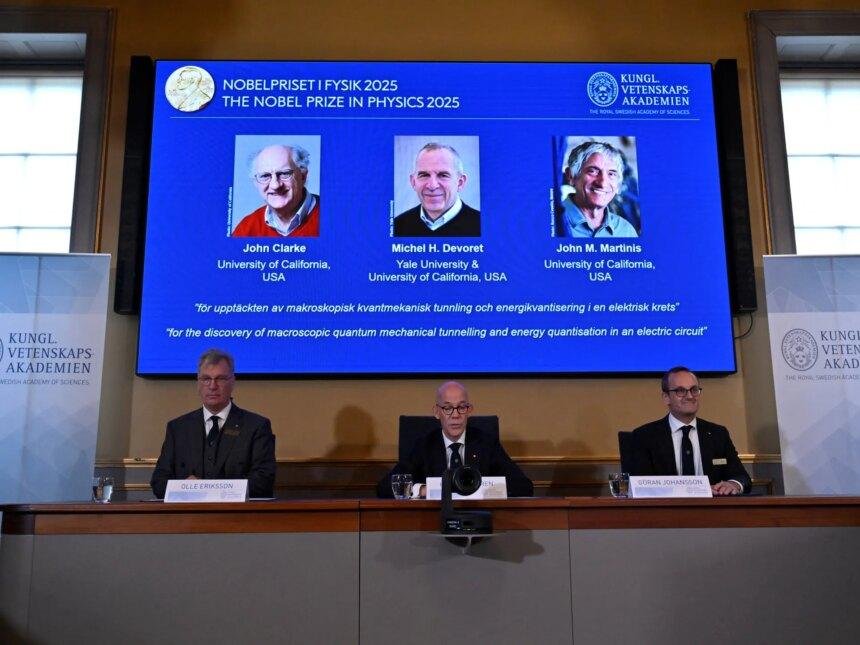Nobel Prize in Physics 2025: A Breakthrough in Quantum Mechanics
The Royal Swedish Academy of Sciences has announced the 2025 Nobel Prize in Physics, honoring three distinguished scientists-John Clarke, Michel H. Devoret, and John M. Martinis-for their groundbreaking work in quantum mechanical tunneling and energy quantization in electric circuits. This prestigious award, which will be presented in December, recognizes their significant contributions to the field of quantum mechanics, a discipline that has profound implications for the future of technology.
Understanding Quantum Mechanical Tunneling
Quantum mechanical tunneling is a phenomenon where particles can pass through energy barriers that, according to classical physics, they should not be able to cross. This concept, which has been a cornerstone of quantum theory since its inception, has traditionally been observed at microscopic scales. However, Clarke, Devoret, and Martinis have successfully demonstrated that these quantum properties can manifest on a macroscopic scale, a feat that opens new avenues for technological advancements.
The implications of their research extend far beyond theoretical physics. The ability to manipulate quantum states in larger systems paves the way for innovations in quantum computing, cryptography, and sensing technologies. As the Nobel committee noted, their work has “provided opportunities for developing the next generation of quantum technology,” which could revolutionize industries ranging from cybersecurity to telecommunications.
Historical Context and Significance
The journey to this Nobel Prize is rooted in decades of research and experimentation. Quantum mechanics, first formulated in the early 20th century, has undergone significant evolution. Pioneers like Max Planck and Albert Einstein laid the groundwork, but it was not until the latter half of the century that practical applications began to emerge. The development of quantum computers, for instance, has been a hot topic in both academic and commercial sectors, with companies like IBM and Google investing heavily in this technology.
The work of Clarke, Devoret, and Martinis is particularly noteworthy in this context. Their experiments have not only validated existing theories but have also provided a framework for future research. By demonstrating that quantum effects can be observed in larger systems, they have challenged the traditional boundaries of quantum mechanics, suggesting that the principles governing the microscopic world can indeed be applied to macroscopic systems.
The Prize and Its Recipients
The Nobel Prize, valued at 11 million Swedish kronor (approximately $1.17 million), will be equally divided among the three laureates, all of whom are based in the United States. The award ceremony, traditionally held in Stockholm, will also see the recipients receive gold medals from the King of Sweden, a symbol of their remarkable achievements.
John Clarke, a professor at the University of California, Berkeley, has been a leading figure in experimental physics for decades. His work has focused on the intersection of quantum mechanics and electrical engineering, making significant contributions to the understanding of superconductivity and quantum circuits.
Michel H. Devoret, a professor at Yale University, has been instrumental in advancing the field of quantum information science. His research has explored the fundamental limits of quantum measurements and the development of quantum bits, or qubits, which are essential for quantum computing.
John M. Martinis, also affiliated with the University of California, has been a pioneer in the development of superconducting qubits. His work has been crucial in the quest to build scalable quantum computers, and he has played a key role in various high-profile quantum computing projects.
Future Implications of Their Work
The recognition of Clarke, Devoret, and Martinis comes at a time when the race for quantum supremacy is intensifying. Major tech companies and governments are investing billions into quantum research, aiming to harness its potential for solving complex problems that are currently beyond the reach of classical computers. The trio’s findings could accelerate this race, providing a clearer path toward practical applications of quantum technology.
Quantum cryptography, for instance, promises to revolutionize data security by utilizing the principles of quantum mechanics to create unbreakable encryption methods. Similarly, advancements in quantum sensors could lead to unprecedented precision in measurements, impacting fields such as medicine, navigation, and environmental monitoring.
Conclusion
The awarding of the 2025 Nobel Prize in Physics to John Clarke, Michel H. Devoret, and John M. Martinis marks a significant milestone in the ongoing exploration of quantum mechanics. Their work not only enhances our understanding of the quantum world but also lays the groundwork for future technological innovations that could transform various industries. As the world stands on the brink of a quantum revolution, the contributions of these scientists will undoubtedly resonate for years to come, inspiring the next generation of researchers and innovators in the field.











